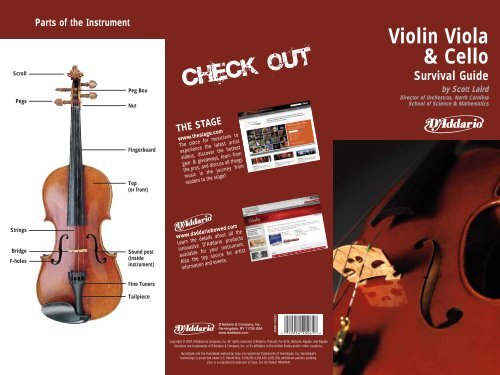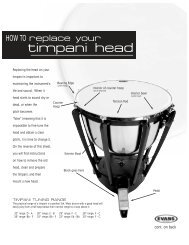Violin, Viola And Cello Survival Guide - D'Addario Bowed Strings
Violin, Viola And Cello Survival Guide - D'Addario Bowed Strings
Violin, Viola And Cello Survival Guide - D'Addario Bowed Strings
You also want an ePaper? Increase the reach of your titles
YUMPU automatically turns print PDFs into web optimized ePapers that Google loves.
Scroll<br />
Pegs<br />
Parts of the Instrument<br />
Peg Box<br />
Nut<br />
Fingerboard<br />
Top<br />
(or front)<br />
THE STAGE<br />
www.thestage.com<br />
The place for musicians to<br />
experience the latest artist<br />
videos, discover the hottest<br />
gear & giveaways, learn from<br />
the pros, and discuss all things<br />
music in the journey from<br />
student to the stage!<br />
<strong>Violin</strong> <strong>Viola</strong><br />
& <strong>Cello</strong><br />
<strong>Survival</strong> <strong>Guide</strong><br />
by Scott Laird<br />
Director of Orchestras, North Carolina<br />
School of Science & Mathematics<br />
<strong>Strings</strong><br />
Bridge<br />
F-holes<br />
Sound post<br />
(inside<br />
instrument)<br />
www.daddariobowed.com<br />
Learn the details about all the<br />
innovative D’Addario products<br />
available for your instrument.<br />
Also the top source for artist<br />
information and events.<br />
Fine Tuners<br />
Tailpiece<br />
BOBR-VSG07<br />
#19954-BACGBg<br />
Copyright © 2007 D’Addario & Company, Inc. All rights reserved. D’Addario, Prelude, Pro-Arté, Helicore, Kaplan, and Kaplan<br />
Solutions are trademarks of D’Addario & Company, Inc. or its affiliates in the United States and/or other countries.<br />
Humidipak and the Humidipak waterdrop logo are registered trademarks of Humidipak, Inc. Humidipak’s<br />
technology is protected under U.S. Patent Nos. 5,936,178; 6,244,432; 6,021,026; additional patents pending.<br />
Zyex is a registered trademark of Zyex, Ltd. US Patent #5587541
K A P L A N<br />
Caring for your Instrument & Bow Installing & Tuning <strong>Strings</strong> Selecting the Proper String<br />
Instrument Care<br />
Preparation<br />
1) You will need replacement strings, a sharp<br />
pencil, and tuner.<br />
2) Loosen and replace only one string at a time.<br />
Removing all the strings together will cause the<br />
bridge to fall.<br />
String Types, Definitions & Characteristics<br />
Humidify<br />
Clean<br />
Apply<br />
rosin<br />
• Always store and use the instrument at<br />
room temperature.<br />
• Use a humidifier or the Planet Waves<br />
Humidipak ® to avoid damage caused by<br />
humidity variations.<br />
• After each playing session, use a soft cloth<br />
to remove rosin residue from the instrument.<br />
• Keep the instrument safely inside its case<br />
when not in use.<br />
• <strong>Strings</strong> should be replaced regularly to<br />
assure the best tone and response.<br />
• Always refer any repairs to a qualified string<br />
instrument repair technician or luthier.<br />
Bow Care & Rosin<br />
• Avoid handling the bow hair directly with<br />
your fingers.<br />
• Tighten the bow hair by turning the metal<br />
screw at the frog end of the stick clockwise<br />
several turns.<br />
• Do not tighten the bow too much. The stick<br />
of the bow should curve toward the hair.<br />
• Always loosen the bow when you finish<br />
playing and for storage.<br />
• Never use the bow to hit or tap anything.<br />
• Bow hair wears out and needs to be<br />
replaced about once per year by your<br />
instrument dealer.<br />
• Bow hair requires rosin. The best performing<br />
rosins are made of natural materials,<br />
formulated to a fine grain.<br />
• Apply rosin by rubbing the rosin cake along<br />
the full length of the bow hair using 6 to 8<br />
long strokes.<br />
• Rosin will melt if it gets too hot. Do not<br />
store it where the temperature will exceed<br />
100 degrees F.<br />
Remove the old string<br />
1) Hold the instrument with the top facing you.<br />
2) Loosen the string by turning the top of the peg<br />
toward you.<br />
3) Gently pull the string off the peg by hand, and<br />
remove the ball-end from the tailpiece.<br />
Install the new string<br />
1) Rub the tip of the pencil in the empty string<br />
grooves of the bridge and nut.<br />
2) Place the ball-end of the new string into the<br />
tailpiece or fine-tuner.<br />
3) Insert the other end into the small string hole at<br />
the midpoint of the peg.<br />
4) Gently turn the top of the peg away from you,<br />
wrapping the string around the peg.<br />
5) Wind the string so that the wrappings are close<br />
together going toward the peg handle.<br />
6) Tighten the string enough to remove the slack.<br />
Make sure that the string is going through the<br />
correct bridge and nut grooves.<br />
Pitch & Tune<br />
1) Using your tuner to hear the proper note, turn the<br />
top of the peg away from you while lightly<br />
plucking the string, bringing it up to the correct<br />
pitch. (You may need to push the peg gently into<br />
the peg box to get it to hold without slipping.)<br />
2) If there is a fine tuner for the string, use the<br />
tuning peg to get the string close to pitch, and<br />
make small corrections with the fine tuner.<br />
3) Check the bridge to make sure it has not started<br />
to lean during the process.<br />
4) Be very careful not to tune the string too high or<br />
thestring will break.<br />
Repeat these steps for the other strings.<br />
Solid steel core – Relatively bright and clear sound, easy<br />
bow response, quick break-in time, and very stable and<br />
durable.<br />
Stranded steel core – Warm clear sound, easy bow<br />
response, quick break-in time, and very stable and<br />
durable.<br />
Synthetic core – Warmer and richer sound<br />
than steel, and more stable and durable<br />
than gut core strings.<br />
Gut core – Warm and rich tone, but slow to break in,<br />
less stable in tuning, and the least durable of all string<br />
types. Gut core strings are recommended only for<br />
advanced players.<br />
Kaplan Solutions Specialty <strong>Strings</strong>:<br />
String players often face specific performance problems<br />
or needs that can be addressed by using a specialized<br />
string. An example is the “whistling” problem that<br />
violinists can encounter when playing their open E.<br />
This can be avoided by using the Kaplan Solutions<br />
Non-Whistling E string.<br />
<strong>Viola</strong> A string – produces greater projection in the higher<br />
register while still blending with the other strings on the<br />
instrument.<br />
<strong>Cello</strong> A & D strings – produce a rich and powerful sound<br />
while supporting the heavy bow pressure that many<br />
players use.<br />
OLDEN•SPIRA<br />
SOLO<br />
String durability<br />
String deterioration occurs as a result of both normal use and corrosion. Any string’s<br />
tone will naturally degrade over time and also may eventually break. <strong>Strings</strong> should be<br />
replaced regularly rather than waiting for them to break.<br />
G<br />
L





